Research on superconductivity in the CDT is wide ranging, spanning fundamental studies of the origin of the pairing interaction and other competing phases, across theory and the fabrication of novel devices.
Imaging competing orders in high TC cuprates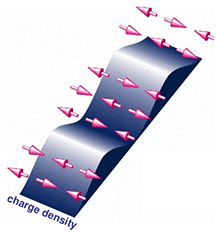 High temperature superconductivity (HTS) in layered cuprates occurs in the proximity of other ordered phases with broken symmetry. These include the “pseudogap” phase, spin-density wave order and (recently discovered) charge density wave order. Understanding the relationship of these competing (or possibly promoting) phases will be key to unravelling the origin the HTS phenomenon. We use x-ray and neutron scattering to investigate the nature of the competing phases. Experiments are performed at synchrotrons and neutron facilities in Europe and beyond.Supervisor(s)Professor Stephen Hayden, University of Bristol
High temperature superconductivity (HTS) in layered cuprates occurs in the proximity of other ordered phases with broken symmetry. These include the “pseudogap” phase, spin-density wave order and (recently discovered) charge density wave order. Understanding the relationship of these competing (or possibly promoting) phases will be key to unravelling the origin the HTS phenomenon. We use x-ray and neutron scattering to investigate the nature of the competing phases. Experiments are performed at synchrotrons and neutron facilities in Europe and beyond.Supervisor(s)Professor Stephen Hayden, University of Bristol
- Superconducting energy gap structure
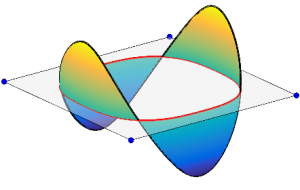 The structure of the superconducting energy gap D(k) is perhaps our most informative window on the structure of the interactions which cause electron pairing and hence superconductivity. To determine DD we use a combination of measurements of magnetic penetration depth and specific heat conducting at temperatures down to 0.04K, using custom built apparatus. Specific heat measurements are extended to very high fields (>30T) at the HMFL Nijmegen. State of the art single crystal samples are grown at Bristol and by collaborators in Kyoto, Stanford and Munich.
The structure of the superconducting energy gap D(k) is perhaps our most informative window on the structure of the interactions which cause electron pairing and hence superconductivity. To determine DD we use a combination of measurements of magnetic penetration depth and specific heat conducting at temperatures down to 0.04K, using custom built apparatus. Specific heat measurements are extended to very high fields (>30T) at the HMFL Nijmegen. State of the art single crystal samples are grown at Bristol and by collaborators in Kyoto, Stanford and Munich.- Supervisor(s)
- Professor Antony Carrington, University of Bristol
- Electronic structure using quantum oscillations
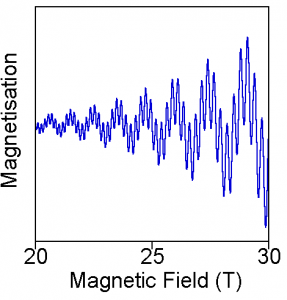 Magneto-quantum oscillations are a powerful probe of electronic structure, giving precise information about the quasiparticle properties and structure of the Fermi surface. Measurements are conducted at low temperature and very high magnetic fields both in Bristol and at international high magnetic field centres (Toulouse, Nijmegen, and Tallahassee). A particular theme is using pressure to tune the properties of the superconductor, allowing different regions of the phase diagram to be investigated systematically using a single sample and without introducing disorder.
Magneto-quantum oscillations are a powerful probe of electronic structure, giving precise information about the quasiparticle properties and structure of the Fermi surface. Measurements are conducted at low temperature and very high magnetic fields both in Bristol and at international high magnetic field centres (Toulouse, Nijmegen, and Tallahassee). A particular theme is using pressure to tune the properties of the superconductor, allowing different regions of the phase diagram to be investigated systematically using a single sample and without introducing disorder.- Supervisor(s)
- Professor Antony Carrington and Dr. Sven Friedemann, University of Bristol
- Magnetic imaging in unconventional superconductors
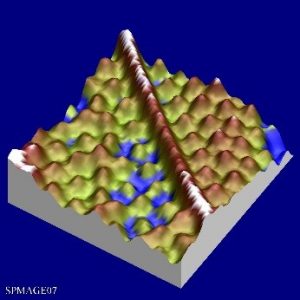 The properties of superconductors in a magnetic field, in particular the behaviour of vortex matter, can reveal important information about unconventional forms of electron pairing as well as the electronic band-structure near the Fermi surface. Magnetic imaging using nanoscale scanning Hall probes is performed at temperatures down to 300mK to identify the signatures of novel superconducting condensates. For example, order parameters that break time reversal symmetry can lead to spontaneous chiral currents (magnetic fields) and unusual vortex phenomena.
The properties of superconductors in a magnetic field, in particular the behaviour of vortex matter, can reveal important information about unconventional forms of electron pairing as well as the electronic band-structure near the Fermi surface. Magnetic imaging using nanoscale scanning Hall probes is performed at temperatures down to 300mK to identify the signatures of novel superconducting condensates. For example, order parameters that break time reversal symmetry can lead to spontaneous chiral currents (magnetic fields) and unusual vortex phenomena.- Supervisor(s)
- Professor Simon Bending, University of Bath
- Superconducting spintronics
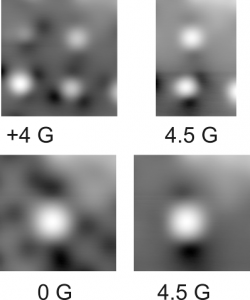 Novel superconducting pair correlations can be formed at superconductor-ferromagnet (S-F) interfaces where spin degeneracy is broken. The conversion of conventional spin singlet Cooper pairs into spin triplet pairs at an S-F interface with non-collinear magnetisation is being explored in novel spintronic devices. The non-collinear magnetisation structure found in spin valves, magnetic vortices and other more complex spin textures such as skyrmions, is being exploited to optimise and control triplet pair generation.
Novel superconducting pair correlations can be formed at superconductor-ferromagnet (S-F) interfaces where spin degeneracy is broken. The conversion of conventional spin singlet Cooper pairs into spin triplet pairs at an S-F interface with non-collinear magnetisation is being explored in novel spintronic devices. The non-collinear magnetisation structure found in spin valves, magnetic vortices and other more complex spin textures such as skyrmions, is being exploited to optimise and control triplet pair generation.- Supervisor(s)
- Professor Simon Bending, University of Bath
- Gate-induced superconductivity in 2D materials
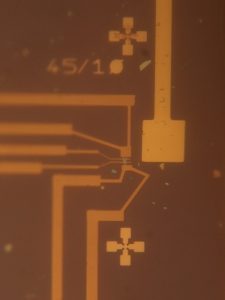 New correlated electron states can be induced in molecular layers of so-called ‘2D materials’ by very high carrier doping. Field effect ‘doping’ with ionic liquid gates is being used to induce very high charge densities in few-layer graphene and transition metal dichalcogenide samples, allowing the evolution of insulating, metallic and superconducting states to be systematically tracked. Other types of correlated electron phases such as ferromagnetism and charge density waves are being sought at extremely high carrier densities.
New correlated electron states can be induced in molecular layers of so-called ‘2D materials’ by very high carrier doping. Field effect ‘doping’ with ionic liquid gates is being used to induce very high charge densities in few-layer graphene and transition metal dichalcogenide samples, allowing the evolution of insulating, metallic and superconducting states to be systematically tracked. Other types of correlated electron phases such as ferromagnetism and charge density waves are being sought at extremely high carrier densities.- Supervisor(s)
- Professor Simon Bending, University of Bath
- Modulation of low carrier density superconductivity with light
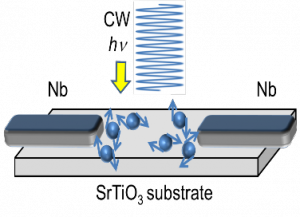 SrTiO3 is an extremely unusual superconductor because of its very low carrier density. The ratio of the Fermi temperature to the superconducting energy gap approaches unity. This low density means that very substantial changes to the properties can be engineered by illuminating the same with visible light. This allows the production of light-tunable superconducting devices which are fabricated with e-beam lithography.
SrTiO3 is an extremely unusual superconductor because of its very low carrier density. The ratio of the Fermi temperature to the superconducting energy gap approaches unity. This low density means that very substantial changes to the properties can be engineered by illuminating the same with visible light. This allows the production of light-tunable superconducting devices which are fabricated with e-beam lithography.- Supervisor(s)
- Dr. Chris Bell, University of Bristol
- Spin and heat currents in superconductors
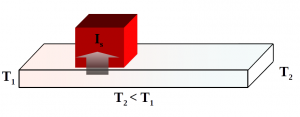 Traditionally superconductors were considered incompatible with magnetism. This view has been revised in recent year as more and more aspects of superconductivity have emerged where it is intertwined with magnetism. One particular aspect we are working on is the theory of generation of spin polarised currents in superconductors via the application of temperature gradients. This combination of the potential use of heat losses to effectively create spin polarised currents used in magnetic storage devices is fundamental basic research aiming for long term applications.
Traditionally superconductors were considered incompatible with magnetism. This view has been revised in recent year as more and more aspects of superconductivity have emerged where it is intertwined with magnetism. One particular aspect we are working on is the theory of generation of spin polarised currents in superconductors via the application of temperature gradients. This combination of the potential use of heat losses to effectively create spin polarised currents used in magnetic storage devices is fundamental basic research aiming for long term applications.- Supervisor(s)
- Dr. Martin Gradhand, University of Bristol
-
- Graphene with proximity-induced superconductivity
 The superconducting order in a superconductor does not decay infinitely quickly at the surface. As a result, its paired state can be carried over to an adjacent normal metal – a phenomenon known as the proximity effect. We are currently studying theoretically the electronic and optical properties of graphene with proximity-induced superconductivity in order to establish whether optical probes can distinguish between the possible order parameters that can be induced in graphene.
The superconducting order in a superconductor does not decay infinitely quickly at the surface. As a result, its paired state can be carried over to an adjacent normal metal – a phenomenon known as the proximity effect. We are currently studying theoretically the electronic and optical properties of graphene with proximity-induced superconductivity in order to establish whether optical probes can distinguish between the possible order parameters that can be induced in graphene.- Supervisor(s)
- Dr. Marcin Mucha-Kruczynski, University of Bath
